




| Home | Features | Club Nights | Underwater Pics | Feedback | Non-Celebrity Diver | Events | 18 July 2025 |
| Blog | Archive | Medical FAQs | Competitions | Travel Offers | The Crew | Contact Us | MDC | LDC |

|

|
 
 |
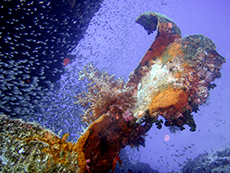 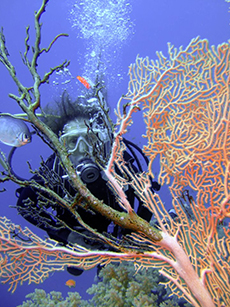 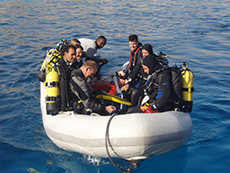 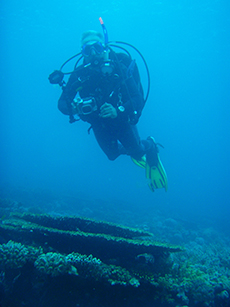 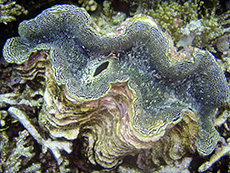 ISSUE 16 ARCHIVE - ELECTIONS, GUIDES AND WASHING MACHINESJuliet SavigearGetting away from the Crowds in the Northern Red SeaIs it really possible to dive the Thistlegorm with no other dive groups pushing you out of their way? Or quietly enjoy the peace of Shark and Yolanda Reef without the orchestra of dive guide rattles and cacophony of knives clanging on tanks and the constant whirring of boat engines above your head? Well maybe not always, but on the whole, yes, this is possible. And now seems to be a good time to do it. One of the joys for us foolhardy Brits, and particularly the water loving kind, is that we are rarely put off going somewhere that is making the news with regular violent clashes. Especially if the city where all the action is taking place is six hundred kilometres from where we intend to be. In fact, the Egyptian presidential elections that were looming when I travelled over there, are really quite interesting and amusing if you start to take a closer look. Who will come out victor is more like guessing who will win the Grand National. Just like the Grand National there are a huge number of entries for the presidential race, but with new regulations and legislation being brought in, there are many candidates falling at the pre-election fences. At the point I write this feature there are twelve candidates on the field with ten people disqualified. The odds are constantly changing, as no election poll seems to be bringing out a consistent leader of the field. These will, of course, be over with by the time you read this article, but what comes as a result I will not even attempt to guess. However, as a holidaying diver you will be oblivious to all things in world politics from the moment you arrive at the airport of Sharm el Sheikh. Once you’ve got your visa and passport stamped and found your luggage, you’re next concern is where you’ll be getting a crate of Sakara before boarding the liveaboard – however, fear not, a small off-license will be a certain stop off before heading to Travco Marina.
Crate of Sakara and dive bag on the trolley, I went to board my namesake, MY Juliet, at the end of April this year, together with a small group of eight other divers. As is often the case, most of the other divers were experienced Red Sea liveaboarders and we only had one diver, Neil, who was a Red Sea virgin. There were two couples, both keen underwater photographers and five solo travellers. Welcoming us on board was the dive guide, Wael Ali, who has worked on MY Juliet for seven years [a while before this, our well-loved, Rob, spent his year guiding on this very same vessel]. So this takes us to the next vital part on how to ensure a quiet northern Egyptian dive site. A decent guide will keep you away from the glass bottom boats and novice divers face- planting in the sand whilst attempting their fin pivots at Temple or White Knights for your check dive. We headed straight off to Beacon Rock to dive the wreck of the Emperor Fraser. A perfect site with calm, easy conditions. A decent reef with the wreck of the liveaboard that sunk on 16th December 2009 sitting in thirty metres of water. Not another dive boat in sight. It all felt strangely natural as I slipped back into the water after a break of two years after having been pregnant and simply enjoying motherhood. Even the wetsuit still fitted – although I could definitely have done with another layer in the 23 degree water. Moving onwards and heading off to Abu Nuhas should prove a good challenge for any dive guide to keep their group away from the crowds. But this did not appear to be a problem for Wail. Abu Nuhas is on the itinerary of every liveaboard in the northern Red Sea and a few day boats from Hurgharda too. This reef has proved to be the end of a few fine ships that have now been firmly taken over by the sea and, as a result, strange beings dressed in neoprene usually followed by a string of bubbles can regularly be found around here. Indeed there was the odd boat dotted about on the surface, but not so many as I had seen in the past. Our tour of these famous wrecks started with the oldest wreck, The Carnatic. This passenger ship sunk in 1869 and makes a very beautiful wreck with the decking beams making it a particularly picturesque dive. The next day, we were firmly moored to the reef as we gracefully clambered into the ribs to head off to each of the Abu Nuhas wrecks. If only I could claim that the re-entry into the high-sided ribs was equally smooth – it was not long till my buddy (Patrick) and I had a firm agreement to always return in the smaller of the two ribs. Chrisoula K – tick. Fabulous dive with wonderful corals. Kimon M – tick. Another good dive to do. Although, this was one of the rare dives that we were accompanied by other divers – a group of hardcore techie divers with no bubbles either. The final dive of Abu Nuhas, is one that most boats dive in the mornings, but for us it was our last one of the afternoon, The Giannis D. This has to be one of the most photographed wrecks of Abu Nuhas, and indeed it does make a stunning underwater subject. Just a shame that both my buddy’s and my cameras decided to kill their batteries just five minutes into the dive. It was around this point in the itinerary that one can become vaguely aware that political activities may have some impact on our diving. My number one night dive spot is currently out of bounds – Gubal Island and the three miles around it is closed and completely off-bounds by military command. So no night dive on The Barge. Another favourite site for many divers, the Rosalie Moller, is also currently not permitted for dive boats coming from Sharm El Sheikh (although apparently this is sometimes possible from dive boats coming from Hurghada – check with your dive company). Dive boats that are found breaking these restrictions will be impounded. Other sites affected are the Ulysses and Malak. Our journey made it’s way back towards the northern end of the Straits of Gubal in the Gulf of Suez to the reef system known as Sha’ab Ali. Here Wael took us to one of his, understandably, favourite sites of the wreck of the Karema. Not many boats seem to take their divers here and unless your guide knows the currents here well, then it is certainly not recommended. Unlike the other sites, Wael had no fancy 3D dive map on the Tv to show us for the briefing, just his own simple sketch. Depending on which way the current is going will be a key decision on where to drop divers to avoid them heading off into the blue. This site gives a good opportunity to see dolphins and also provides one of the best coral reefs that I have dived in the Red Sea. Shoals of bumphead parrotfish cruise the reef together with the usual colourful array of marine life. The wreck of the Karema also provides the metal lovers with plenty of broken rusted structures. The ship was of a similar design to the Dunraven and has a most unusual and striking propeller set up. The dive can certainly involve a hard bit of finning, but this has to be rated in one my top sites. Back on deck and keeping our eyes out to the distance, we could clearly spot the flotilla of dive boats that mark the iconic dive site of the Thistlegorm. Choosing to hold back from the mob another day, Wael kept MY Juliet moored on Sha’ab Ali and took us for a dive on the Kingston and a beautiful night dive. A sleepy Napoleon wrasse had found a snug hole in the reef for his bedroom, sea pens extended their quills on the sandy bottom and basket stars had come out from their daytime hiding places to prominently splay their branched arms on any exposed part of the reef to feed on the plankton – simply stunning. No liveaboard covering the northern Red Sea will miss out on the most popular dive site of the Thistlegorm. The liveaboards will often dive this first thing in the morning whilst the day boats from Sharm will then join a little later. I will not go into the details of this famous merchant navy vessel, as that is already the subject of many a book. We were moored a little way off the Thistlegorm to be taken to the dive site by RIB. Delaying the dive till just after the other liveaboards, those that chose to do the first dive of this infamous wreck, enjoyed this majestic ocean gravesite to themselves in perfect conditions. However, it would be completely unreasonable to expect this again, and indeed the second dive on the site was joined by other groups. Nonetheless, the divers that came back from the second dive all came back remarking how they had never had such a thorough tour of the inside holds of the Thistlegorm, the contents of which make this dive site so fascinating. I have to admit that this was my lazy day and did neither of the dives here – well, as a new mother I was taking it somewhat easy and instead watched the continual passage in the sky of the migrating honey buzzards. Before steaming our way up the Gulf of Aqaba, there was an gentle dive on the Dunraven and Beacon Rock. An early start (rather unusual for Wael’s easy, relaxed guiding) saw Team Juliet the first of the dive boats on another of the Red Sea iconic dive sites – Shark and Yolanda reef. It is a joy to be the only divers on this site, as there is so much variety and plenty of life on these reefs. Having motored our way up to the Straits of Tiran, our tour of the four reefs that form the reef system here, began with the most southerly, Gordon. Deliberately dropping us in the blue, Wael hoped to avoid most of the other dive groups as he took us around the southern tip away from the standard dives of this reef. We surfaced just in time before the currents picked up. The full moon was bringing the spring tides and currents were getting strong. Even Wael had to make a last minute call on Thomas reef and change direction, but what a magnificent dive. Anthias were everywhere, sergeant major fish were nesting in the crevices, jacks and tuna cruised by in the blue. The last chance for a night dive for the avid, diver (well done Andrea for jumping in the water at every opportunity given) was on Jackson reef. And certainly, those that dived this one were not to be disappointed. Now most of us have dived Jackson reef a number of times. I don’t think I was the only person whose eyebrows raised slightly when Wael told us that we shall be diving ‘The Washing Machine’ for our first dive of the day. ‘The Washing Machine’ is clearly marked on all dive maps of these reefs with a large exclamation mark and a warning of strong currents. Well, his knowledge of the Red Sea currents has done us well throughout the week and to no surprise the gentle current that morning was perfect to drop down onto the saddle between Jackson and Woodhouse reefs. There was no dive map to accompany his briefing, rather a towel and a couple of other random items on the table. As this section is rarely dived, the quality of the reef here is spectacular and reminded me more of those of Elphinstone with gorgonians, black corals and spiralling whip corals filling the reef slopes and walls. There is the chance of turtles and sharks – even the elusive hammerhead shark, but the very least you’ll get is one of the most stunning reefs of the Red Sea... and no other divers. A final dive on Ras Um Sid kept Team Juliet away from the crowds before the crew got the bbq ready for party night. Moored in the quiet bay at Temple, the Sakaras and rum came out to celebrate a week when we really did manage to keep away from the crowds and get to see some of the quieter sides of even the most popular sites. On our last day, the pedestrian parade along Naama Bay is rather quiet without mass of tourists. Enjoy. Juliet was diving MY Juliet through OonasDivers in May 2012. For more details and future itineraries: tel: 01323 648924 |